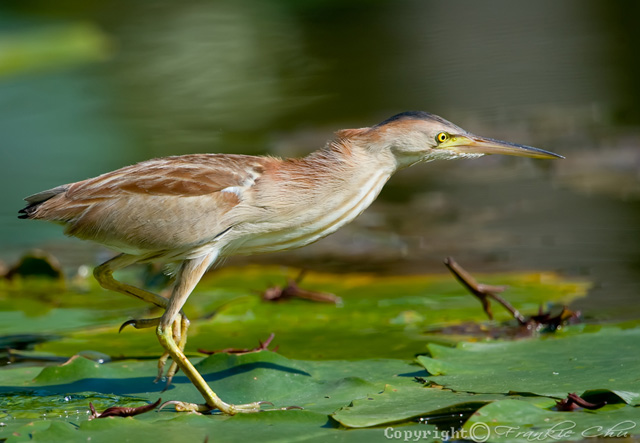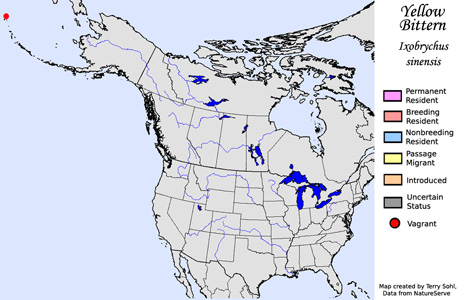| Length: 15 inches | Wingspan: 21 inches | Seasonality: Non-resident in South Dakota |
| ID Keys: Yellowish-brown overall, darker above and lighter below, black crown, long yellowish bill, yellow legs | ||
 The
Yellow Bittern is an Asian species, where they are found in parts of eastern
Asia, from Japan in the north to Indonesia in the south. In North
America, a confirmed sighting has only occurred once, on Attu Island on the
far outer edge of the Aleutian Island chain. They are very similar in
structure to North America's Least Bittern, and ecologically fill a very
similar niche. The Yellow Bittern is found in thick wetland
vegetation, where they can sometimes be difficult to observe. However,
they will also sometimes forage in the open, and they will readily fly when
disturbed, although flight tends to be rather low and for only short
distances.
The
Yellow Bittern is an Asian species, where they are found in parts of eastern
Asia, from Japan in the north to Indonesia in the south. In North
America, a confirmed sighting has only occurred once, on Attu Island on the
far outer edge of the Aleutian Island chain. They are very similar in
structure to North America's Least Bittern, and ecologically fill a very
similar niche. The Yellow Bittern is found in thick wetland
vegetation, where they can sometimes be difficult to observe. However,
they will also sometimes forage in the open, and they will readily fly when
disturbed, although flight tends to be rather low and for only short
distances.
Habitat: Found in wetlands and marshes, flooded rice fields, and coastal mangroves.
Diet: Feeds on a variety of aquatic life, including small fish, amphibians, aquatic insects and their larvae, and crustaceans.
Behavior: Yellow Bitterns tend to stay in thick wetland vegetation, and can be difficult to observe. They also are often most active at dawn or dusk, or are nocturnal, making observation even more difficult. They forage by moving slowly through the wetland vegetation or waiting at the water's edge, thrusting their long bill out to capture prey when prey is spotted.
Nesting: Nesting occurs in areas of herbaceous vegetation, where a nesting platform is constructed from reeds and other wetland vegetation. The female lays between 3 and 5 eggs. Both parents help to incubate the eggs, and both parents help to raise the young after the eggs hatch. The young leave the nest after about 2 weeks.
Song: Yellow Bitterns are usually silent
Migration: Yellow Bitterns are considered permanent residents throughout much of their range, but birds in the northern part of their breeding range will move short distances south for the winter. Given that the species is typically a short-distance migrant at best, additional sightings in North America are not considered very likely.
Interactive eBird map: Click here to access an interactive eBird map of Yellow Bittern sightings
Similar Species: In North America, most similar to the Least Bittern. In their Asian range, they are most similar to the Cinnamon Bittern.
Conservation Status: Populations are thought to be stable, they are found over a very wide geographic area, and they are common in parts of their range. The IUCN lists the Yellow Bittern as a species of "Least Concern".
Further Information: 1) BirdLife International - Yellow Bittern
2) ILoveIndia.com - Yellow Bittern Account
3) Whatbird - Yellow Bittern
Photo Information: Photo taken by Frankie Chu - Photo licensed under Creative Commons Attribution NoDerivs 2.0 Generic License
| Click below for a higher-resolution map |
 |
| South Dakota Status: Non-resident in South Dakota |
Additional Yellow Bittern Photos (coming soon!!)
